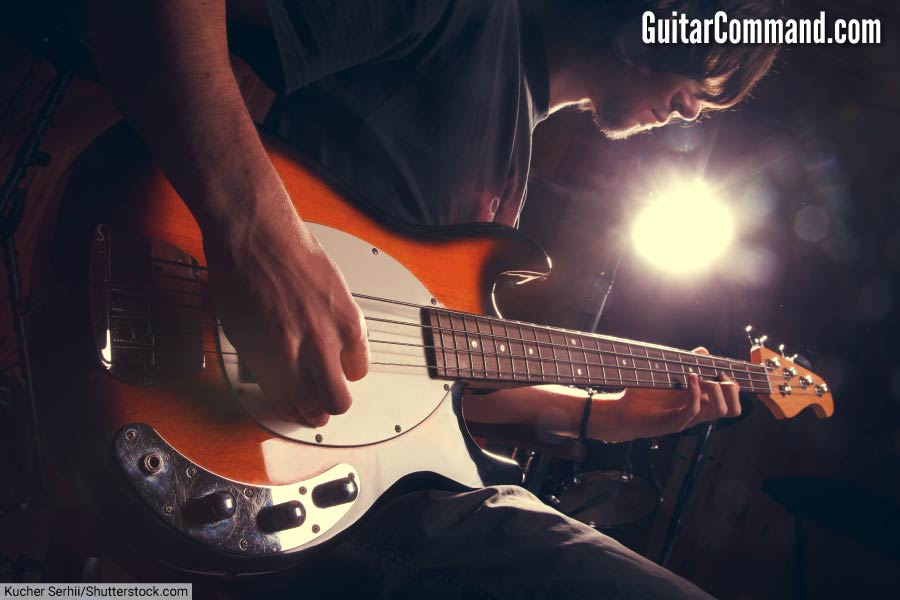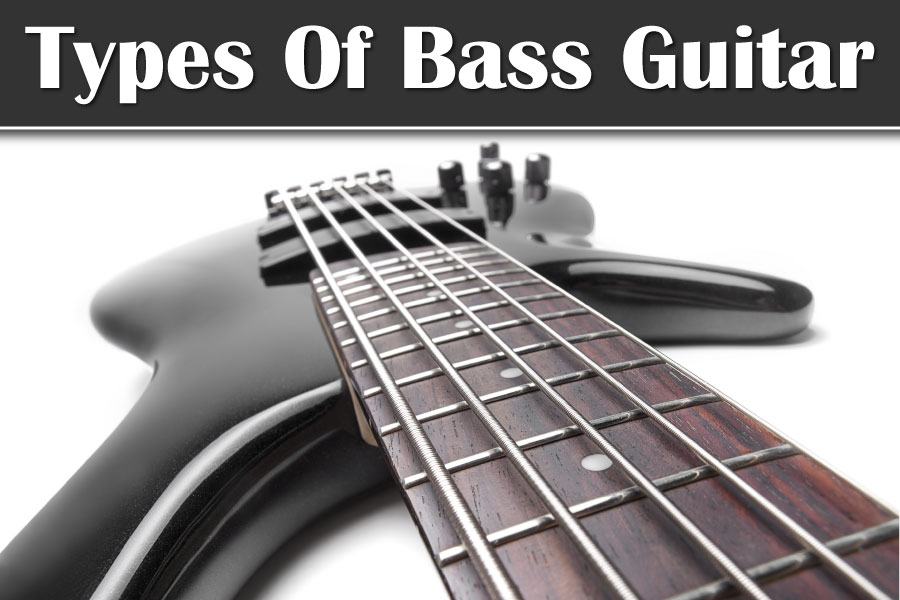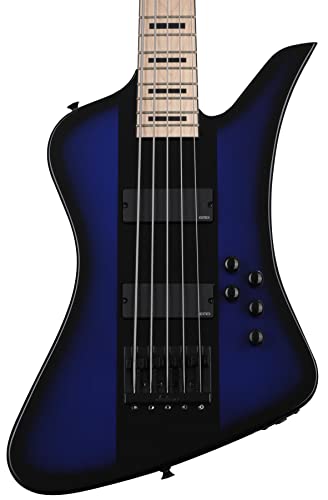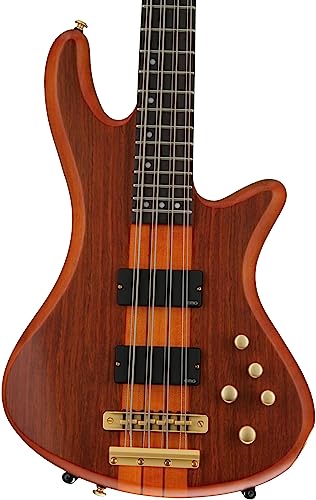Types of bass guitar include the standard, 4-string solid-body electric bass, bass guitars with 5 or more strings, active and passive basses, acoustic basses and fretless basses. There are also different types of standard bass guitars, including the iconic p-bass and j-bass guitars; short-scale basses for smaller player, and basses styled for particular musical genres.
On this page you’ll find information on the different types of bass guitar, with examples of each…
Page Index
5-String Bass Guitar (And Basses with 6+ Strings)
Hollow-Bodied / Semi-Acoustic Bass Guitar
Related Pages
Jazz Bass vs Precision Bass: Which Is Best For You?
Bass vs Guitar: The Difference Between Bass & Electric Guitar
Playing Bass Guitar – Your Complete Beginner’s Guide
Introduction
Although the bass guitar often flies under the radar for most audience members - particularly compared to lead vocals or electric guitar - it’s one of the most important pieces of any musical puzzle.

The bass guitar gives music bounce and groove, supplies the low-end of a band’s sound and plays a vital harmonic role.
Would any Beatles song sound the same without Paul’s melodic walking bass? Would Michael Jackson’s “Billie Jean” be a guaranteed floor-filler without that iconic opening bass line?
How much of these and other iconic bass lines are down to the type of bass guitar that was used?
Paul McCartney is famous for using a semi-acoustic Höfner violin bass for much of his career, while session bassist Louis Johnson apparently used every bass in his collection before settling on a Yamaha model for the recording of Billie Jean.
For a long time, there were only two types of basses: upright and electric. These days, however, there are many different types of electric bass guitars.
Some have more than the standard 4 strings, others are suited to particular genres, and fretless and acoustic models are also available.
On this page we list the main types of bass guitar to help you decide which is best for you and your music…
Standard Bass Guitar

The “standard” bass guitar has four strings, one or two pickups, and a solid body. Its neck might be bolted on, as is the case for Fender-style basses, or either a set-neck or neck-through-body configuration as per Gibson-style basses.
The neck itself will have metal frets to enable precise fingering of notes, and will be of the "long-scale" variety (see the short-scale bass section for a comparison).
The neck may be made of maple, mahogany, or a wood with similar properties. Common woods for the fingerboard / fretboard include maple, rosewood and pao ferro. A number of woods are used to make bass guitar bodies, including alder, ash, basswood, maple and mahogany.
The above describes the majority of basses sold and used today. This type of bass is highly versatile and used by bass guitarists in almost every genre of contemporary music, from extreme metal to pop.
Being a solid-bodied, electric instrument, the bass guitar requires an amp (amplifier) in order to produce a useable sound.
Lacking a hollow cavity and a sound hole, the bass produces nothing more than a very quiet, metallic twang when played unamplified.
Nearly all bass guitars are modelled to a greater or lesser degree on either the Fender Precision bass, or the Jazz bass made by the same company. We look at these in more detail below, and you'll also find a comparison on this page: Jazz Bass vs Precision Bass.
So familiar are these two basses that their imitators are often labelled as being either “p bass” or “j bass”-style.
Fender’s main American competitor in the world of solid-bodied electric guitars, Gibson, followed its rival by producing its own electric basses, including iconic instruments such as the Thunderbird and EB-3.
We recommend that your first bass should be a standard bass guitar. Only once you have progressed beyond the basics should you start looking at more specialized instruments such as fretless, acoustic basses, or basses with more than four strings.
Below are three typical types of bass guitar:
Fender Precision Bass
- Alder Body with gloss finish
- One player Series split-coil precision bass middle pickup
- Master volume and tone controls
- “Modern C"-Shaped neck profile
- 9. 5"-Radius Fingerboard
The Fender Precision bass, or “P-bass”, was the first bass guitar to achieve widespread success. As a result, most electric basses are based to greater or lesser degrees on the original P-bass design.
Four strings, a bolt-on neck, a single pickup (usually a humbucker, occasionally a single-coil pickup), and a fretted neck make this bass the industry standard in a variety of genres. The P bass is a versatile, powerful workhorse that has been a staple of live performance ever since its introduction to market in 1951.
Fender Jazz Bass
- Alder Body with gloss finish
- Two player Series single-coil jazz bass pickups
- Two volume controls, master tone control
- “Modern C"-Shaped neck profile
- 9. 5"-Radius Fingerboard
Fender’s other main bass guitar, the Jazz bass, was meant to improve on the design of the P bass and appeal to virtuoso jazz players.
This is reflected in its design, with its offset body shape, twin single-coil pickups, and brighter, richer mid-heavy tone.
Don’t let the name fool you; the Fender Jazz bass is every bit as versatile an instrument as its older brother. You’ll find Jazz bass players in just about every genre of music, with elite players like Geddy Lee, Flea, and Jaco Pastorius all wielding the Jazz bass at one time or another.
Gibson Thunderbird
- 34” scale, a 12” radius, and 20 medium jumbo frets
- vintage styled 60s Tune-o-matic bridge
- Claw tailpiece
Gibson’s Thunderbird was introduced in 1963, over a decade after Fender introduced their pioneering Precision bass. The Thunderbird differed from the P and J basses considerably, with a number of design differences contributing to its characteristic tone.
The Thunderbird has neck-through-body construction, compared to Fender basses’ bolt-on neck. That means the neck and body is a single piece of wood, with the Thunderbird’s asymmetrical “wings” attached on either side. This increases the sustain of the Thunderbird.
The Thunderbird also tends to have higher output thanks to its humbucking pickups. This, and the use of mahogany as a tonewood, gives the Thunderbird a distinctive “growling” tone widely favored by players in heavier genres of music.
Active vs Passive Bass Guitar
Most bass guitars are passive; their electronics are relatively simple, with the string’s vibrations being turned into an electrical signal via their magnetic pickups.
Passive basses can produce quite a low-powered signal, and this can lead to a significant amount of extraneous noise being amplified along with the bass’s own signal.
This is generally not a problem; most basses are passive and perform perfectly adequately.
Active basses are equipped with circuitry to boost the signal.
An active bass has either active pickups, or (more commonly nowadays) passive pickups and an active pre-amp. Some active basses have both.
Whatever the style of “active” bass, its active electronics will use an onboard power supply (nearly always a battery) to produce a more powerful signal. This provides a clearer signal and also enables the player to alter their sound by boosting certain frequencies (on a passive bass guitar, frequencies can only be reduced).
Although some bassists prefer the more powerful signal and added versatility of an active bass, many others prefer the more natural sound and simplicity (including no battery requirements) of a passive bass.
5 String Bass Guitar
Virtuoso bass players looking to get more out of their instruments began experimenting with bass guitars with more than four strings.
Today, it’s not unusual to see players wielding basses with five, six, and even seven or eight strings. These “extended” bass guitars are particularly popular in heavy and progressive genres.
- Neck Shape: Info not available Wood: Maple Neck joint: Bolt-on Scale length: Info not available Truss rod: Standard Finish: Satin Pickups Active or passive pickups: Passive Pickup configuration: HH Neck: PowerSpan Middle: Not applicable Bridge: PowerSpan Brand: Ibanez Series or parallel: Info not available Active preamp: Not applicable Special electronics: 3-way Power Tap switch Fretboard
- For 25 years the SR has given bass players a modern alternative
- Embraced by bassists over the decades, the iconic series continues to excite with its smooth, fast neck, lightweight body and perfectly matched electronics
- The SR405EQM is a handsome 5-string bass designed for the experienced player
- The bass starts with an immaculately finished Mahogany body topped with gorgeous quilted maple
5-string basses tend to be tuned B-E-A-D-G. That is, they have an additional lower string tuned to the B below the usual low E string.
Some players choose to tune their 5-string bass to E-A-D-G-C, with the C on the fifth string above the G note of the fourth string.
As with the electric guitar, extended-range basses are typically tuned in fourths.
Often, you’ll find extended-range basses in smaller ensembles where the ability to comp and play chords as well as bass lines on the same instrument is valuable.
It’s rare to see an extended-range bass in a band with multiple chordal instruments such as the electric guitar or piano, although Megadeth’s Dave Ellefson played the Jackson 5-string bass shown below alongside two guitar players for his tenure in the band.
- X Series Signature David Ellefson Kelly Bird V Bass - Blue Stripe
Although beginners are recommended to learn the basics on a standard, four-string bass, basses with 5-plus strings can expand the instrument's potential.
Bass Guitars With 6 Or More Strings
- One right-handed Squier Classic Vibe 6-string bass guitar with three individual pickup on/off switches, plus the Jaguar-type 'low-frequency-attenuating' (high-pass) filter
- Vintage Style: The Squier Classic Vibe 6-String Bass VI, tuned an octave lower than a guitar and featuring a vintage-style tremolo, is the perfect companion for any guitar or bass player into uncharted territory
- 100% Designed by Fender: a faithful tribute to the secret weapon of producers and adventurous players that have dared to explore it since its original production from 1961 to 1975
- Vintage Style Tuning Machine: Sporting classic looks, these vintage style tuning machines provide rock solid tuning stability and smooth action
- 2-Year Limited Warranty: Fender guitars are built with unmatched quality, down to the last screw- which is why Fender warrants this Fender acoustic guitar to be free from defects in materials and workmanship for two (2) years from original purchase
The six-string bass is usually tuned to the same notes as a standard six-string guitar - that is, E-A-D-G-B-E, but an octave lower. The Fender Bass VI shown above is one example of a six-stringed bass.
Some basses have even more strings than a standard guitar. Usually, the tunings for these extended-range basses are:
- Seven-string bass: F♯ to C or B to F
- Eight-string: F♯ to F
- Nine-string: F♯ to B♭
- Ten-string: C♯ to B♭ or F♯ to E♭
- Eleven-string: C♯ to E♭ or F♯ to A♭
- Twelve-string: C♯ to A♭ or B to G♭.
An example of an 8 string bass is Schecter’s Stiletto Studio-8, shown below.
- 8-string Electric Bass with Mahogany/Bubinga Body
- 2 Humbucking Pickups - Honey Satin
- Rosewood Fingerboard
- Maple/Walnut Neck
Acoustic Bass Guitars
- Solid spruce top and mahogany back and sides.
- Slim-taper, easy-to-play neck profile found on all Classic Design guitars.
- Equipped with a flexible Fishman electronics system.
It’s important to make a distinction here. Technically, the double bass, or “upright bass” that preceded the solid-bodied electric bass, is an “acoustic bass”.
However, when talking about acoustic basses, most people today mean bass guitars that are shaped like acoustic guitars.
Acoustic basses have hollow, acoustically resonant bodies and can be played without an amp, although most are fitted with some sort of magnetic or piezo pickup system that allows them to be amplified if necessary.
The heyday of the acoustic bass guitar was, arguably, MTV’s iconic Unplugged series, which saw electrified rock bands stripping back to play acoustic renditions of their greatest hits.
Acoustic basses aren’t nearly as common as electric basses for a number of reasons. Chief among these is that, unlike the clear sonic difference between an acoustic guitar and an electric guitar, acoustic bass guitars don’t sound that different from an electric bass, at least as far as most audience members are concerned.
Acoustic basses are also, by virtue of playing low-pitched bass tones, nowhere near as loud or as authoritative as a well-built acoustic guitar.
Finally, in most modern touring ensembles, even those that play ostensibly acoustic music, the performance is amplified in some way anyway. Accordingly, the standard, solid-bodied electric bass remains the more popular choice, being less cumbersome, less fragile and more versatile than its acoustic counterpart.
With all that being said, there are some great acoustic bass guitars on the market. Fender’s Kingman, for example, uses a combination of acoustically resonant solid spruce top and a Jazz-style neck to deliver an acoustic bass for players more accustomed to electric playing.
- One right-handed Fender Kingman Acoustic Bass Guitar
- California Player: Decked out in the electric-inspired style of Fender’s California Player series, this acoustic bass guitar delivers the full, deep acoustic projection and comfortable playing feel you expect from Fender.
- Premium Materials: Painted spruce top and mahogany construction, a mahogany jazz bass neck, and a walnut fingerboard
- Enhanced Playability: Easily enhance and control your sound with the built-in Fishman Classic Design pickup/preamp tuner
- 2-Year Limited Warranty: Fender guitars are built with unmatched quality, down to the last screw- which is why Fender warrants this Fender acoustic guitar to be free from defects in materials and workmanship for two (2) years from original purchase
Hollow-bodied / Semi-Acoustic Bass Guitars
The hollow-bodied bass guitar, like a hollow-bodied electric guitar, is more associated with traditional and Americana-style genres.
It boasts an undeniable old-school cool factor, and remains favored by country, rockabilly, and blues players to this day.
Hollow-bodied bass guitars tend to have a “woodier”, thumping tone, as opposed to the more articulate or aggressive tones you can hear from hollow-bodied bass guitars.
As is the case with hollow-bodied electric guitars, this is largely thanks to their increased resonance, which means they tend to use lower-output pickups to minimize the risk of feedback when played through an amp.
As such, hollow-bodied basses are less commonly used in the heavier genres of music. It’s more common to hear the percussive “whoomp” of a hollow-bodied bass in classic and retro-style music than in hard rock.
Think rockabilly, country, and British Invasion-era guitar music. Hollow-bodied basses are definitely more for those into pompadours and mop tops than shaggy Slash hair or Mohawks.
Take the Gretsch G5442BDC, for example, with its maple top, rockabilly-ready Filtertron pickups, and classic twang. As with many Gretsch guitars, this hollow-bodied bass fully embraces everything great about the mid-1950s guitar boom.
On the other side of the Atlantic, you had Paul McCartney of the Beatles wielding his famous violin-shaped Hofner bass guitar. That thumping, melodic bass sound was the backbone of the Beatles’ earliest hits, and modern players looking to recapture some of the Fab Four’s magic need look no further than this iconic hollow-style bass guitar.
Fretless Bass Guitars
- 100% designed by Fender
- Inspired by 1960s-era Jazz Bass models
- Fender-Designed alnico pickups
- Vintage-tinted gloss neck finish
- Nickel-plated hardware
A fretless bass is a bass that lacks frets on the fingerboard. Although most fretless basses still have markings where the frets would be, all lack the metal frets that separate the individual semitones. This allows the smooth glides between notes that are a characteristic of fretless bass.
In certain situations, a fretless bass can sound wonderful, but in reality, those situations are limited and you’ll probably find that a fretted bass is far more versatile.
Without frets, you may find that exact pitching of notes is challenging. We wouldn't recommend you choose a fretless as your first bass guitar, but it could be something you come to specialise in further down the line.
Short Scale Basses
- Fast, slim Maple neck
- Compact, light-weight Body
- Dynamic P pickup
- Short Scale 28. 6"
A bass guitar is quite an unwieldy instrument and musicians of a smaller stature may find it uncomfortable to play in its standard, long-scale configuration.
Short-scale basses, whose necks are shorter and frets correspondingly closer together, are significantly easier to handle than standard basses.
Although often marketed as beginner, or kid's bass guitars, short-scale basses have a sound and feel all of their own, and are occasionally used in preference to long scale basses, even by bassists of normal stature!
A short-scale bass guitar can be a good option for kids or for those for whom a standard-size bass is simply too big. However, you may want to try one even if you don't fit those categories.
The Fender Mustang is one of the best-known short-scale bass guitars:
- 24” scale length; “C”-shaped maple neck
- Two Mustang single-coil pickups
- 9. 5”-radius maple fingerboard with 22 medium jumbo frets
- Six-saddle string-through-body hardtail Strat bridge with bent steel saddles
- Master Volume and Tone controls; three-way pickup switch
Basses for Metal
Metal is a genre in which virtuosity is the standard, and brutal, punishing tones are expected. Metal bassists often place heavy demands on their instruments and are therefore among the most discerning of all bassists.
While some metal bassists stick to classic, time-tested bass guitar models (e.g., Iron Maiden’s Steve Harris, who still plays his trust Fender P-bass to this day.), others demand basses specifically made for metal. Metal basses tend to have excellent playability and produce high output.
However, there are some great basses aimed at metal players, like the Warwick Rockbass Corvette, or Schecter’s five-stringed Stiletto.
- Ebony Fingerboard
- Schecter Custom String-Thru Body Bridge
- Mahogany Body with Quilted Maple Top
Shecter’s branding in particular tends to appeal to metal players, as their edgy, aggressive designs perfectly capture the aesthetic of the music.
Related Pages
Jazz Bass vs Precision Bass: Which Is Best For You?
Bass vs Guitar: The Difference Between Bass & Electric Guitar















